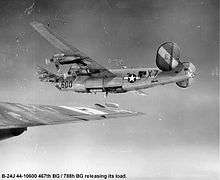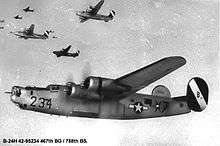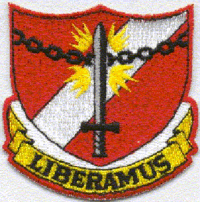467th Bombardment Group
| 467th Bombardment Group | |
|---|---|
|
467th Bombardment Group Insignia | |
| Active | 1943–1946 |
| Country | United States |
| Branch | United States Army Air Forces |
| Role | Bombardment |
| Part of | Eighth Air Force |
| Garrison/HQ | European Theatre of World War II |
The 467th Bombardment Group is an inactive United States Army Air Forces unit. Its last assignment was to the Strategic Air Command, being stationed at Clovis Army Airfield, New Mexico. It was inactivated on 4 August 1946.
During World War II, the group was an Eighth Air Force B-24 Liberator unit in England assigned to RAF Rackheath. The group set unsurpassed record for bombing accuracy on 15 April 1945, holding the record for bombing accuracy in the Eighth Air Force. They destroyed a German battery at Pointe de Grave, on the west coast of France and scored a 100 per cent strike. The group commander, Colonel Albert J. Shower, was the only group commander to stay with the same group from beginning to the end of the war. Returned to the United States in July 1945, converted to B-29 Superfortresses and trained for deployment to the Pacific Theater. Deployment to Okinawa cancelled with the end of the Pacific War in August 1945.
After training completed, assigned to Clovis AAF, New Mexico and was one of the original ten USAAF bombardment groups assigned to Strategic Air Command on 21 March 1946. The group was inactivated on 4 August 1946 due to the Air Force's policy of retaining only low-numbered groups on active duty after the war, and its B-29 aircraft, personnel and equipment were reassigned to the senior 301st Bombardment Group at Smoky Hill Army Airfield, Kansas.
History


Established as a B-24 Liberator heavy bombardment group in mid-1943 at Mountain Home Army Air Field, Idaho, and activated on 8 September. Transferred to Kearns Center, Utah for personnel assignment and organization then sent to Wendover Field, Utah for combat training on 1 November.
In January the group received deployment orders for the European Theater of Operations (ETO). On 12 February 1944 the ground unit went by train to Camp Shanks, New York. They sailed on the USAT Frederick Lykes on 28 February 1944 and arrived in Clyde on 10 March 1944. The aircraft left Wendover on 12 February 1944 and took the southern Atlantic ferry route. One B-24 was lost with all the crew over the Atlas mountains. Moved to RAF Rackheath, Norfolk in England, February–March 1944, and was assigned to the VIII Bomber Command. The group was assigned to the 96th Combat Bombardment Wing, and the group tail code was a "Circle-P".
The mission of the 467th was to engage in very long range strategic bombardment operations over Occupied Europe and Nazi Germany. The group began operations on 10 April 1944 with an attack by thirty aircraft on an airfield at Bourges in central France. In combat, the unit served chiefly as a strategic bombardment organization, attacking the harbor at Kiel, chemical plants at Bonn, textile factories at Stuttgart, power plants at Hamm, steel works at Osnabrück, the aircraft industry at Brunswick, and other objectives.
In addition to strategic operations, engaged occasionally in support and interdictory missions. Bombed shore installations and bridges near Cherbourg on D-Day, 6 June 1944. Struck enemy troop and supply concentrations near Montreuil on 25 July 1944 to assist the Allied drive across France.
In September, over two weeks the bombers flew gasoline from Rackheath to Clastres Airfield (A-71) France for use by the US mechanized forces. Attacked German communications and fortifications during the Battle of the Bulge, December 1944 – January 1945. Hit enemy transportation to assist the Allied assault across the Rhine in March 1945.
After the German Capitulation in May 1945, the group was ordered back to the United States for B-29 transition and redeployment to the Pacific Theater of Operations (PTO). Redeployed to the US June/July 1945. The air echelon departed Rackheath on 12 June 1945. The ground units sailed from Greenock on the Queen Mary on 6 July 1945. They arrived in New York on 11 July 1945. Upon arrival, most of the group was demobilized due to their combat service in Europe; a cadre of officers and men was formed at Sioux Falls Army Air Field, South Dakota on 25 August.
At Sioux Falls, the unit was redesignated as the 467th Bombardment Group (Very Heavy) in August and was reformed with newly trained pilots, aircrews and ground personnel. The reformed group was sent to Harvard Army Airfield, Nebraska for initial Second Air Force training then on to Phase II training at Alamogordo Army Airfield, New Mexico where the group trained on worn II Bomber Command B-17s and some pre-production YB-29s used for aircrew training. The Japanese Capitulation in early August canceled the planned deployment to the Pacific, however the group continued to train
Due to the advanced training state of the unit, it was reassigned to Harvard Army Airfield, Nebraska, where the group received new B-29 Superfortresses and completed training. In December 1945 was assigned to a permanent base at Clovis AAF, New Mexico as part of Continental Air Forces.
Engaged in strategic bombardment training operations on a reduced scale upon arrival at Clovis, as many personnel were being demobilzed. On 21 March 1946, was assigned as one of the initial units of the new Strategic Air Command. The unit, however was inactivated on 4 August due to personnel shortages and funding reductions in the immediate postwar Air Force. The equipment and remaining personnel were reassigned to other SAC units, primarily the 301st Bombardment Group at Smoky Hill Army Airfield, Kansas.
Lineage
- Constituted as 467th Bombardment Group (Heavy) on 19 May 1943
- Activated on 1 August 1943
- Redesignated 467th Bombardment Group (Very Heavy) in August 1945
- Inactivated on 4 August 1946, aircraft/personnel/equipment redesignated 301st Bombardment Group
Assignments
- II Bomber Command, 1 August 1943
- Second Air Force, 6 October 1943 – 12 February 1944
- 96th Combat Bombardment Wing, 7 March 1944 – 12 June 1945
- Second Air Force, 15 July 1945
- Strategic Air Command, 21 March – 4 August 1946
Components
- 788th Bombardment Squadron (X7), 1 August 1943 – 4 August 1946
- 789th Bombardment Squadron (6A), 1 August 1943 – 4 August 1946
- 790th Bombardment Squadron (Q2), 1 August 1943 – 4 August 1946
- 791st Bombardment Squadron (4Z), 1 August 1943 – 4 August 1946
Stations
|
|
Aircraft
- B-24 Liberator, 1943–1945
- B-17 Flying Fortress, 1945–1946
- B-29 Superfortress, 1946
References
![]() This article incorporates public domain material from the Air Force Historical Research Agency website http://www.afhra.af.mil/.
This article incorporates public domain material from the Air Force Historical Research Agency website http://www.afhra.af.mil/.
- Freeman, Roger A. Airfields of the Eighth: Then and Now. After the Battle, 1978. ISBN 0-900913-09-6.
- Freeman, Roger A. The Mighty Eighth: The Colour Record. Cassell & Co., 1991. ISBN 0-304-35708-1.
- Maurer, Maurer. Air Force Combat Units Of World War II. Maxwell AFB, Alabama: Office of Air Force History, 1983. ISBN 0-89201-092-4.
- Watts, Perry. The 467th Bombardment Group (H) in World War II: in Combat with the B-24 Liberator over Europe. Atglen, Pennsylvania: Schiffer Publishing, 2006. ISBN 0-7643-2165-X.
External links
| Wikimedia Commons has media related to 467th Bombardment Group. |


